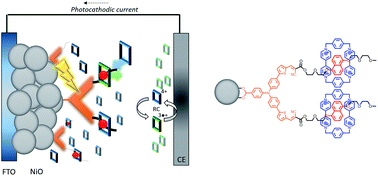p-Type dye-sensitized solar cells based on pseudorotaxane mediated charge-transfer†
Abstract
The efficiency of p-type dye-sensitized solar cells (DSSCs) remains low compared to that of n-type congeners due to charge recombination events. We report a supramolecular approach to reduce recombination at the NiO–dye interface, realized by using the cyclophane cyclobis(paraquat-p-phenylene) ring (RING4+/RING3˙+) as a redox mediator and a dye (PN) functionalized with a 1,5-dioxynaphthalene (DNP) recognition site, promoting the supramolecular formation of a pseudorotaxane capable of directing charge transfer away from the NiO–dye interface. The binding affinity of RING4+ to PN is high (Kass = 3.4 × 104 M−1), with quenching of the photoexcited dye (PN*) ascribed to reduction of RING4+ to RING3˙+. The reduced RING3˙+ exhibits a lower binding affinity to PN, facilitating exchange with the excess RING4+ present in solution. This supramolecular phenomenon was implemented into p-type DSSCs by anchoring the PN dye on a NiO photocathode in conjunction with the RING4+/RING3˙+ redox couple, yielding a 10 fold enhancement in the short-circuit photocurrent (JSC) compared to control devices utilizing P1 dye or the methylviologen (MV2+/MV˙+) redox couple that cannot form pseudorotaxanes.

- This article is part of the themed collection: Artificial photosynthesis


 Please wait while we load your content...
Please wait while we load your content...